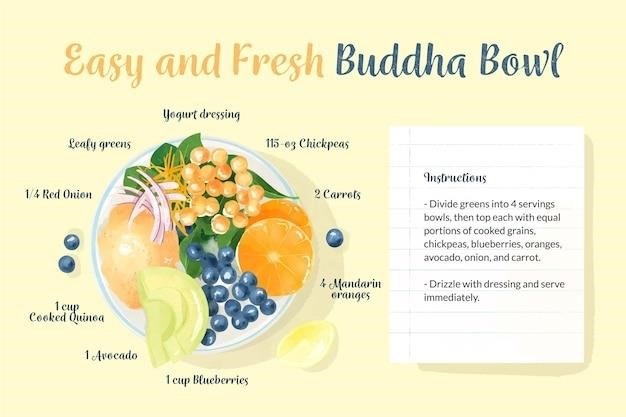Carb Cycling⁚ A Guide to Meal Planning and Benefits
Carb cycling is a popular dietary approach that involves alternating between high-carb and low-carb days to optimize your body’s metabolic rate and energy levels. It is often used to help people lose weight, build muscle, and improve athletic performance. Carb cycling can be a good option for those looking to manage their weight and improve their overall health, but it’s important to consult with a healthcare professional before making any significant changes to your diet.
What is Carb Cycling?
Carb cycling, also known as the intermittent low-carb diet, is a dietary strategy that involves alternating between high-carb and low-carb days to achieve specific fitness and health goals. This approach is based on the idea that manipulating carbohydrate intake can optimize the body’s metabolic rate and energy levels. By strategically varying carb intake, carb cycling aims to⁚
- Boost energy levels for intense workouts⁚ On high-carb days, the body has ample glycogen stores, providing the fuel needed for vigorous exercise, leading to improved performance and recovery.
- Promote fat burning⁚ On low-carb days, the body switches to utilizing stored fat for energy, potentially leading to increased fat loss.
- Prevent plateaus⁚ By fluctuating carb intake, carb cycling can prevent the body from adapting to a consistent calorie or macronutrient intake, which can sometimes lead to weight loss plateaus.
Carb cycling is not a one-size-fits-all approach and requires careful planning and consideration of individual needs and goals. It’s important to note that carb cycling is not a magic bullet for weight loss or performance enhancement. It’s crucial to combine it with a balanced diet, regular exercise, and sufficient rest for optimal results.
Benefits of Carb Cycling
Carb cycling offers a range of potential benefits for individuals seeking to improve their physique, performance, and overall health. While more research is needed to fully understand its long-term effects, the following are some of the key advantages associated with this dietary approach⁚
- Enhanced athletic performance⁚ Carb cycling can help athletes optimize their energy levels for intense workouts, leading to improved performance and faster recovery times. By ensuring sufficient glycogen stores on high-carb days, athletes can fuel their training sessions effectively.
- Increased fat loss⁚ By strategically manipulating carb intake, carb cycling can promote fat burning by forcing the body to utilize stored fat as a primary energy source on low-carb days. This can be beneficial for those seeking to reduce body fat and improve body composition.
- Improved metabolic rate⁚ Carb cycling can stimulate the metabolism by creating a “metabolic confusion,” forcing the body to adapt to fluctuating energy sources. This can potentially lead to increased calorie expenditure and a more efficient metabolism.
- Reduced appetite⁚ On low-carb days, the body may experience a decrease in hunger hormones, leading to reduced appetite and easier calorie restriction. This can be helpful for those struggling with food cravings and overeating.
- Improved blood sugar control⁚ By controlling carb intake, carb cycling can help regulate blood sugar levels, potentially benefiting individuals with insulin resistance or type 2 diabetes. However, it’s crucial to consult with a healthcare professional for personalized advice.
It’s important to note that individual responses to carb cycling can vary. While some may experience positive results, others may not see significant benefits. Always consult with a healthcare professional or a registered dietitian to ensure carb cycling is appropriate for your individual needs and goals.
Carb Cycling Meal Plan PDF
A carb cycling meal plan PDF is a valuable resource for individuals looking to implement this dietary approach effectively. These PDFs typically provide detailed information on carb intake, meal timing, and food choices for both high-carb and low-carb days. They often include sample meal plans, recipes, and tips for success. A well-structured carb cycling meal plan PDF can help individuals⁚
- Simplify meal planning⁚ PDFs offer pre-designed meal plans that take the guesswork out of carb cycling, making it easier to follow the diet consistently.
- Provide portion control guidance⁚ Carb cycling meal plans often include portion sizes for each meal, ensuring that individuals stay within their calorie and macro goals.
- Offer recipe inspiration⁚ Carb cycling meal plan PDFs often feature a variety of recipes that are both delicious and compliant with the diet’s guidelines.
- Promote accountability⁚ Having a physical copy of the meal plan can help individuals stay accountable and motivated to stick to their dietary goals.
When choosing a carb cycling meal plan PDF, it’s essential to select one created by a qualified professional, such as a registered dietitian or certified nutritionist. This ensures that the plan is safe, effective, and tailored to your individual needs and goals.

Sample Carb Cycling Schedule
A sample carb cycling schedule typically outlines the days of the week where high-carb and low-carb days are implemented. This schedule can be tailored to individual preferences and fitness goals. Here are three common options for structuring a carb cycling schedule⁚
- Level 1⁚ Every Other Day⁚ This schedule alternates high-carb and low-carb days, providing a consistent pattern throughout the week. For example, Monday, Wednesday, and Friday could be high-carb days, while Tuesday, Thursday, and Saturday are low-carb days.
- Level 2⁚ Tuesday, Friday, and Sunday⁚ This schedule includes two high-carb days on the weekend, which can be beneficial for those who enjoy social gatherings or active weekends. Monday, Wednesday, and Thursday would be low-carb days.
- Level 3⁚ Wednesday and Saturday⁚ This schedule is more challenging, featuring only two high-carb days per week, typically Wednesday and Saturday. This option is often chosen for individuals seeking more aggressive fat loss results.
Remember, these are just sample schedules. It’s essential to experiment and find a carb cycling pattern that works best for your body and lifestyle. It’s also crucial to avoid having two consecutive high-carb days to allow your body to effectively utilize stored glycogen reserves and promote fat burning.
Carb Cycling Meal Plan⁚ High Carb Days
High-carb days are essential for replenishing glycogen stores, fueling intense workouts, and supporting muscle recovery. These days are characterized by a higher intake of carbohydrates, typically in the range of 175-275 grams per day. The goal is to provide your body with the necessary energy to perform at its best. Here are some examples of high-carb meals and snacks that can be incorporated into your diet on these days⁚
- Breakfast⁚ Oatmeal with berries and nuts, whole-wheat toast with avocado and eggs, or a protein smoothie with fruit and Greek yogurt.
- Lunch⁚ A large salad with grilled chicken or fish, a whole-wheat wrap with hummus and vegetables, or a bowl of pasta with lean protein and vegetables.
- Dinner⁚ Baked chicken or fish with quinoa and roasted vegetables, a whole-wheat pizza with plenty of toppings, or a stir-fry with brown rice and tofu.
- Snacks⁚ Fruit, yogurt, trail mix, or a protein bar.
It’s important to choose complex carbohydrates, such as whole grains, fruits, vegetables, and legumes, over refined carbohydrates, which can cause blood sugar spikes and crashes. Remember to prioritize lean protein and healthy fats alongside your carbohydrates to create balanced and satisfying meals.
Carb Cycling Meal Plan⁚ Low Carb Days
Low-carb days are designed to promote fat burning and help your body tap into its fat reserves for energy. On these days, your carbohydrate intake will be significantly reduced, typically to 100-125 grams per day. This shift in macronutrient intake encourages your body to utilize stored fat for fuel, leading to potential weight loss and improved body composition.
Here are some ideas for low-carb meals and snacks to incorporate on low-carb days⁚
- Breakfast⁚ Eggs with bacon or sausage, Greek yogurt with berries, or a protein shake with unsweetened almond milk.
- Lunch⁚ A salad with grilled chicken or fish, a bowl of soup with a side of a low-carb vegetable, or a tuna salad sandwich on lettuce.
- Dinner⁚ Grilled salmon with asparagus and broccoli, a chicken stir-fry with cauliflower rice, or a steak with a side of leafy greens.
- Snacks⁚ Nuts, seeds, hard-boiled eggs, or a handful of berries.
Focus on protein-rich foods, healthy fats, and non-starchy vegetables. Avoid sugary drinks, processed foods, and starchy carbohydrates, such as bread, pasta, and potatoes.
Carb Cycling Recipes
Carb cycling recipes are designed to be versatile and adaptable, allowing you to create delicious and satisfying meals for both high and low-carb days. These recipes often focus on protein-rich ingredients, healthy fats, and non-starchy vegetables to provide you with the nutrients you need to fuel your workouts, support muscle growth, and maintain energy levels.
Here are a few examples of carb cycling recipes that you can try⁚
- High Carb⁚ Chicken and Broccoli Stir-Fry with Brown Rice⁚ This recipe combines lean protein from chicken, fiber-rich broccoli, and complex carbohydrates from brown rice, making it a perfect choice for a high-carb day.
- Low Carb⁚ Salmon with Roasted Asparagus and Lemon⁚ This recipe features healthy fats from salmon, fiber-rich asparagus, and a touch of citrus for flavor, making it a suitable option for a low-carb meal.
- High Carb⁚ Oatmeal with Berries and Nuts⁚ This recipe combines complex carbohydrates from oatmeal, antioxidants from berries, and healthy fats from nuts, providing a satisfying and energy-boosting breakfast option.
- Low Carb⁚ Turkey Meatloaf with Cauliflower Mash⁚ This recipe uses ground turkey for lean protein, cauliflower for a low-carb alternative to mashed potatoes, and a blend of spices for flavor, creating a hearty and satisfying meal.
These are just a few examples, and you can find many other carb cycling recipes online or in cookbooks. Remember to adjust the recipes to fit your individual dietary needs and preferences.
Carb Cycling⁚ Tips for Success
Successfully implementing carb cycling requires a combination of careful planning, mindful eating, and consistent effort. Here are some tips to help you maximize your chances of success⁚
- Plan Ahead⁚ Prepare your meals and snacks in advance to avoid making unhealthy choices when you’re short on time or feeling hungry. This includes prepping ingredients, cooking in bulk, and packing healthy snacks for on-the-go.
- Track Your Macros⁚ Keep track of your macronutrient intake (protein, carbohydrates, and fats) to ensure you’re meeting your daily goals. This helps you stay on track with your carb cycling plan and make informed food choices.
- Listen to Your Body⁚ Pay attention to how your body feels throughout the day. If you experience fatigue or low energy levels, adjust your carb intake or meal timing accordingly.
- Stay Hydrated⁚ Drink plenty of water throughout the day to support your metabolism, improve satiety, and prevent dehydration, which can negatively impact your energy levels.
- Be Consistent⁚ Stick to your carb cycling plan as much as possible. Consistency is key to achieving results and establishing healthy habits.
- Don’t Be Afraid to Experiment⁚ Find what works best for you and your body. Adjust your carb cycling plan as needed based on your goals, preferences, and response.
Remember that carb cycling is a dietary strategy that can help you achieve your fitness and health goals, but it’s not a one-size-fits-all approach. It’s essential to listen to your body, adjust your plan as needed, and seek guidance from a qualified healthcare professional.
Carb Cycling⁚ Frequently Asked Questions
Carb cycling can be a confusing concept, leading to many questions. Here are some frequently asked questions about carb cycling and their answers⁚
- What is a good schedule for carb cycling? There are several carb cycling schedules, but a common one is to have high-carb days every other day, alternating with low-carb days. You can adjust the schedule based on your fitness goals and activity levels.
- How to make a carb cycling meal plan? Start by determining your daily calorie needs and macronutrient ratios. Then, plan your meals for high-carb and low-carb days, ensuring you’re consuming adequate protein and healthy fats. A free carb cycling meal plan PDF can provide a structured guide and sample meals.
- Is carb cycling good for weight loss? Carb cycling may be effective for weight loss, as it can help boost your metabolism and increase fat burning. However, it’s crucial to maintain a calorie deficit and a healthy lifestyle for sustainable weight loss.
- What foods can I eat on carb cycling? High-carb days include foods like whole grains, starchy vegetables, and fruits. Low-carb days focus on lean protein, healthy fats, and non-starchy vegetables.
It’s essential to remember that carb cycling is a dietary approach, not a magic solution. It’s best to consult with a healthcare professional or registered dietitian to create a personalized carb cycling plan tailored to your individual needs and goals.


